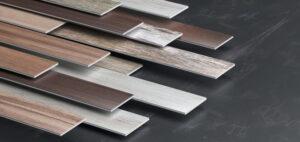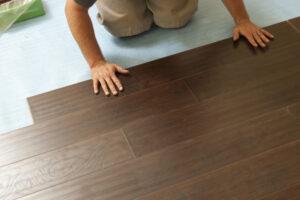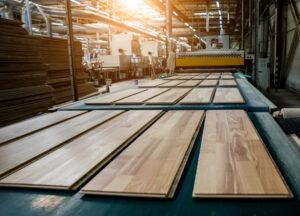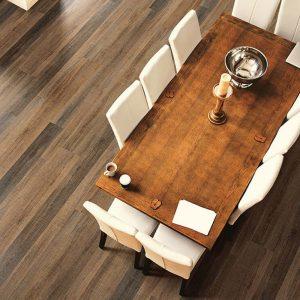When is Laminate Flooring a Better Choice Than Wood?
The quick answer to this question is “it depends.” Laminate flooring is a better choice than wood when it meets a particular set of priorities. At other times, a traditional solid hardwood floor better fills the need. There is no universal answer to this question.
This is especially true today. In just the last few years, we have witnessed some technological advances in solid hardwood flooring and a significant number of technological advances in laminate flooring. We encourage you to learn more about what’s new with laminate. You might be pleasantly surprised.

How to set your flooring priorities
1. Consider how long you’re going to stay in the home.
A high-quality solid wood floor will last 100 years or more with proper installation and reasonable care. This sounds great, but when is the last time you’ve heard of anyone hanging onto their home for that long? Americans tend to move homes quite frequently, especially in some parts of the country.
2. Will this be a do-it-yourself project?
Laminate flooring is relatively easy to install and someone who is moderately handy can complete the installation in a reasonable amount of time. In contrast, the solid wood flooring option can be frustrating and complicated, so hiring a qualified professional is strongly recommended.
3. How large of an area are you planning to tackle?
A typical size bedroom is doable, but a whole house is a formidable project for your average DIYer.

4. Pets and lifestyle.
Although solid hardwood flooring can last a very long time, the top finish may not stand up to as much abuse as a high-quality laminate floor. As a result, you may have to sand down and refinish a solid hardwood floor sooner than you would like. But, again, it depends on what kind of wear and tear you expect. This could mean the size of dog you have and how likely are they to scratch up your floor.
5. Resale value.
A bright and beautiful new laminate floor can do wonders for the appearance of your home, especially if you install it over an entire area. However, the undisputed winner is solid hardwood flooring when it comes to resale value. Both realtors and prospective buyers like the idea of solid hardwood flooring materials.
6. Care and maintenance.
Both flooring choices are a joy to clean with either a broom, dust mop, damp sponge, or a robotic vacuum cleaner.

7. Cost vs. Value.
This isn’t an easy one to figure out, but we’ll give you some ideas. Simple cost does not tell the whole story. Here’s an example: a no-frills laminate flooring usually costs from $1 to $3 per square foot and can last up to 10 years.
On the other hand, a solid ¾ inch thick white oak hardwood in a wide plank can cost several times more. Then add installation and the gap between the two options seems even wider.
However, it might be a lot closer when you amortize the cost over the 100 years of use. You can wrap yourself into a pretzel trying to figure this out. Yet, how do you factor in the pride of ownership or the satisfaction of doing it yourself? The most important question is how much can you afford now?
8. Sound and feel.
Depending on the installation and quality of a laminate floor, it can sound hollow when you walk on it. It’s difficult to describe the different sensations you get from a solid hardwood floor versus a laminate floor when you are in your socks or you sit down on the floor. It is pretty different.

Construction 101
How is solid hardwood flooring made?
Solid hardwood planks have been around for hundreds of years. Typically, the wood species chosen for this type of flooring are white oak, red oak, and maple. Depending on regional preferences, walnut, cherry, and exotics can also be used.
Most of the time, the planks are milled to be ¾ inch thick, 1.5 or 2.25 inches wide, and four feet long. Customized widths can range up to 6 inches. The boards are usually fluted on the underside and milled with tongue and groove edges to help fasten the planks together. The top surface is sanded smooth and is typically left unfinished. The boards are then installed over a properly prepared subfloor.
In the case of a wood subfloor, the hardwood planks are then blind-nailed to the subfloor using the tongue along the edge. Once installed, the owner has the floor sanded, sealed, and stained with the color of their choice. The final step is to apply several coats of urethane to protect both the wood and the stain color from fading in the sunshine, and from wear and tear. This also helps it become more water resistant.
How is laminate flooring made?
Laminate flooring is manufactured with a core layer of specially-treated fiberboard. This gives the laminate plank excellent structural stability, making them less likely to warp or bow.
Overtop of this is a specially printed layer to replicate the desired material like hardwood, softwood, or even stone. Finally, the design layer is coated with an extremely tough wear layer. Laminate flooring planks are usually ¼ inch or ½ inch thick and they are available in several widths.
Installing laminate flooring has been specifically designed to be quick and easy for do-it-yourselfers. Planks are not glued or nailed, or attached in any way to the subfloor. Instead, planks click together at the edges and support each other at the ends. Once installed, the whole floor is unified and “floats” over the subfloor.

Almost infinite possibilities
Laminate flooring and its cost-effective cousin, vinyl plank flooring, come in a staggering number of textures, patterns, and colors.
Flooring manufacturers have made extraordinary advances in mimicking just about every type of wood flooring you can imagine. For example, the intricate grain pattern and colors manufacturers use make it exceedingly difficult to tell the difference between solid oak and oak laminate flooring. Today’s laminate flooring can even replicate the look of ceramic tile and porcelain tile, making it a truly versatile flooring option suitable for almost any room in a home.


